This article was co-authored by Karin Lindquist, a trusted member of wikiHow's volunteer community. Karin Lindquist earned a BSc in Agriculture as an Animal Science major from the University of Alberta, Canada. She has over 20 years of experience working with cattle and crops. She's worked for a mixed-practice veterinarian, as a sales representative in a farm supply store, and as a research assistant doing rangeland, soil, and crop research. She currently works as a forage and beef agriculture extension specialist, advising farmers on a variety of issues relating to their cattle and the forages they grow and harvest.
There are 10 references cited in this article, which can be found at the bottom of the page.
wikiHow marks an article as reader-approved once it receives enough positive feedback. In this case, 93% of readers who voted found the article helpful, earning it our reader-approved status.
This article has been viewed 221,153 times.
Learn more...
Sometimes after a long, hard birth where a cow tries to have a large calf without help and it's in the birth canal too long, or after a hard pull with the pressure of a large calf coming through the pelvis affects the main nerves that control her hind legs. This can also happen in cows that give birth to a normal birth weight calf, particularly if those cows have a smaller-than-normal pelvic area, or heifers that are first-time calvers delivering a normal-sized to a little larger-than-normal calf.
The Gluteal and the Obturator nerves are the ones most affected; the latter more commonly affected than the former. The gluteal nerve is the nerve that controls the muscles to the buttocks. The obturator nerve runs along each side of the pelvic cavity to control the thigh muscles. If this nerve is damaged, the cow cannot pull her hind legs inward and underneath her to stand. Often one leg's more affected than the other, depending on which side she's lying on. Both legs may also be affected, resulting in her unable to get up without some kind of help. If only one leg is affected, she will be able to get up and stand (with a bit of encouragement), and stay up if the weaker leg can be kept from sliding out to the side. The gluteal nerve can also hinder a cow's efforts to get up, however if she does get up, she'll be a bit wobbly when she walks and possibly loose balance.
No matter what nerve is affected, getting the cow up as soon as possible is important, because the sooner she gets up, the quicker she recovers. If she sits for a long period of time, the worse it will be because often paralysis will worsen or get to the point where it is untreatable and you will have to put her down. Things can get especially bad if she's been lying in an awkward position for a while. Knowing the steps on how to get a cow up as soon as possible is very important.
Note: This condition is often referred to by veterinarians as "Obturator Paralysis."[1]
Steps
-
1Contact your local large animal veterinarian to assess whether the reason your cow is down is really from nerve paralysis and not something more serious. The cow may be down not only from obturator/gluteal paralysis, but also from a fracture to the femur or a dislocated hip joint.[2] A fracture of the femur can be severe enough that if you get the cow to stand up without consulting the advice of a vet first, the bone may sever the femoral artery (a main artery that runs along the length on the outside of the hind leg) and she'll bleed to death in a matter of minutes. Another reason that the cow may be down may be from having a case of milk fever, which can also quickly kill her if not treated immediately and appropriately.[3]
-
2Once you have determined the cause that she is down from nerve paralysis, get her to stand up. It may sound cruel to force a cow to get up, but this may minimize or prevent what might otherwise be a more serious issue. She will be tired after a difficult birth and may just want to lie there. The following steps are very effect (FAR more effective than trying to do the nice sweet-talking thing) in getting most cows back up.[4]
- Before you do try to get her up, move her calf away from her so that she won't fall on him if she wobbles and staggers over.
- Twist her tail. Do this by taking the tail halfway down and twisting it into a loop hard enough so that you don't break the tail but can't twist it any more. Hold it there until she gets up or you can't any more (for around 10 to 20 seconds).
- Clap your hands, shout or stomp your feat very loudly to startle her. A flighty cow will normally try to rise if you startle her if you make a sudden noise or movement. A more gentle one won't even try.
-
Suffocating her. This does sound very cruel, but it's an old trick that has worked in getting a stubborn cow back up. All you do is place your hands firmly over her mouth and nostrils tight enough so that she can't breathe. When she starts getting worried about getting short on air, she'll usually try to get up.
- Only try this for 10 to 20 seconds. If the cow won't get back up after 20 seconds, then remove your hands and let her breathe.
- Shocking her with the cattle prod. This is another really dirty trick, but touching the hairless area under the tail with a hotshot or cattle prod will startle almost any cow into attempting to get up.
Advertisement -
3Once (and if) she's up, grab her tail to keep her from falling. You do not want to risk a leg fracture or hip-joint dislocation if she goes down again.
-
4Try to keep her on her feet for a few minutes. If you can do that, generally she'll be less helpless the next time she tries getting on her feet again.
- The longer she stands, the better!
- It may take a couple of people to steady her and keep her from falling over on her numb side (one on her tail, the other on her head)
- She may try to swing or kick that one hind leg a bit because it feels funny, not because she's mad at you for getting her up. It's just like when you get hit in the funny bone or when your arm or leg or foot gets numb and has "pins and needles" from abnormal pressure.
-
5If she goes down again, let her rest for a few minutes before trying to get her up again.
-
6
-
7Keep an eye on her until you are certain that she's figured out how to manage by herself. Often once a cow's up and around, the leg will soon be back to normal again and she'll be able to mother the calf herself without any further issues.
When She Absolutely Cannot Get Up
-
1Make her comfortable. This means doing the following:[5]
- Move her hind legs into a more comfortable and natural position if she tried to get up and her hind legs are all askew.
- Milk colostrum from her while she's lying down (yes, you can milk a cow while the cow is lying down) if she has a live calf. You can feed him from a bottle or bring him to the udder to suckle. Keep him lying down so he's level with the udder and can nurse properly. You will have to guide his mouth to a teat.
- Partition the calf away from the cow if she's in a barn stall, or make a temporary pen for him nearby if she's in a larger area. Make sure you get him back to momma every few hours for him to nurse.
- Hobble her hind legs (if you suspect she'll try to get up without you there to watch or assist) to prevent her from doing the splits when she does Try to fails. Tying the legs together reduces the chances of her fracturing a leg, dislocating her hip or tearing her leg muscles. Position the legs 16" apart and tie a strap or baler twine above the fetlock joints in nonslip knots so it won't tighten and cut off circulation. Don't worry, the hobbles, if done right, won't hinder a cow to get up on her own.
- Keep her warm, clean, sheltered, and well fed. Change the straw put around her often so her rear and udder stays clean. If she's outside and not in a stall and it's cold, wet and stormy out, make a windbreak of bales (can be any size and type) around her in a semi circle, and place a tarp over the bales to act as a shelter. A tarp over her body will also help keep her warm in windy and/or wet weather. Provide fresh hay and water for her, even if she's going to be down for a few hours.
-
2Your vet may prescribe anti-inflammatory medications, Vitamin E, Selenium and steroids for her to assist nerve healing and reduce swelling.
-
3Check on her often and keep trying to get her up. If she still cannot stand, find a way to hoist her up.[6]
- An overhead beam in the barn or a tractor loader helps in these situations.
- You need to do this twice a day for 15 to 20 minutes each time
- Wide belting of some kind, like belting used in balers can be used as a sling. Place it around her front end behind the elbows and around her back end at the flanks.
- Your vet may supply hip lifters (a device that clamps on to the hipbones of the cow) to lift up her hind end that you can borrow.[7]
-
4Turn her over a couple times a day so she's not always laying on one side all the time. She will get what are called "bedsores" from constant pressure and the muscles she's lying on will get sore and fatigued.[8]
-
5Most cows will get up after a few hours or a few days, especially if you are persistent in helping them get up. Periodically stand her up if she'll try. A lot of folks can "tail her up" by hold on her tail to hold her steady for a bit before she goes down again.
- The more you get her up, the better!
-
6If she has been down for a while when you do find her, the outcome may not be as good, and she may need to be humanely euthanized.
Community Q&A
-
QuestionMy baby buffalo is suffering from nerve paralysis. What is the medical treatment for it?
 Community AnswerYou need to talk to your veterinarian. Please do so as soon as possible.
Community AnswerYou need to talk to your veterinarian. Please do so as soon as possible. -
QuestionMy cow is heavily pregnant and has lost power in her back legs. What should I do?
 Community AnswerCall your veterinarian ASAP. There's a possibility that she has a pinched nerve, but it could be something much more serious so you don't want to wait. A call to the vet will diagnose what's wrong and help determine the best course of action to take.
Community AnswerCall your veterinarian ASAP. There's a possibility that she has a pinched nerve, but it could be something much more serious so you don't want to wait. A call to the vet will diagnose what's wrong and help determine the best course of action to take. -
QuestionHow can I make a cow stand after it has been paralyzed?
 Community AnswerPlease read this article: How to Get a Downer Cow Back up After She Naturally Delivered a Very Large Calf, and also call the vet.
Community AnswerPlease read this article: How to Get a Downer Cow Back up After She Naturally Delivered a Very Large Calf, and also call the vet.
Warnings
- Be careful of cows that do suddenly get up and take a turn at you. Some cows may trick you into thinking they are down, and you can get caught between the cow and a hard place if you are not careful or don't have any kind of weapon to protect yourself.⧼thumbs_response⧽
- Always know the symptoms of a cow that is down due to just injury, versus one down with a more serious illness or problem.⧼thumbs_response⧽
- Consult a vet for appropriate medical treatment of a downed cow. Inappropriate treatment may worsen the condition or result in the cow's death.⧼thumbs_response⧽
Things You'll Need
- Hip lifters and/or some kind of belting
- Tractor with front-end loader (optional, if cow is not in a barn)
- Vitamin E, Selenium, and/or steroids from the vet
- Hay/straw bales (optional, if cow is not in a barn)
- Tarp[s]
- Fresh straw
- Bucket for water
- Fresh hay
- Calf bottle with nipple
- Hotshot/cattle prod
- Halter (optional)
- A helper
References
- ↑ https://www.nadis.org.uk/disease-a-z/cattle/calving-module/calving-part-3-nerve-damage/
- ↑ https://www.beefmagazine.com/health/how-treat-leg-fractures-young-calves
- ↑ https://www.dairynz.co.nz/animal/cow-health/milk-fever/
- ↑ https://www.dairyaustralia.com.au/-/media/dairyaustralia/documents/farm/animal-care/animal-welfare/cow-welfare/fact-sheet--how-to-manage-a-down-cow.pdf
- ↑ http://www.thecattlesite.com/diseaseinfo/246/the-downer-cow/
- ↑ https://www.youtube.com/watch?v=REadbA1xz0I
- ↑ https://www.dairynz.co.nz/animal/cow-health/down-cows/
- ↑ https://www.dairynz.co.nz/animal/cow-health/down-cows/
- Thomas H.S. Essential Guide to Calving Chapter 6: Complications Following Pregnancy and Birth. USA: Versa Press. 2008. pp. 130-132, 139-142.
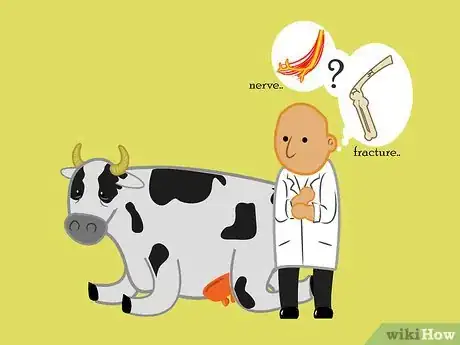
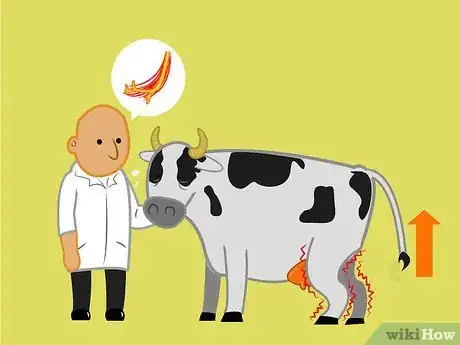
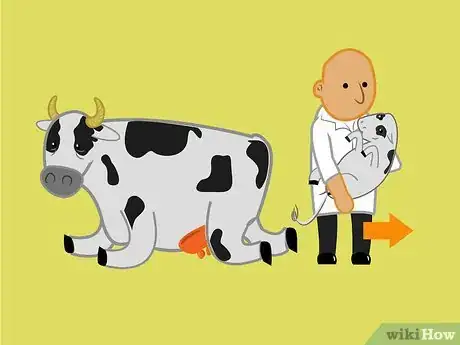
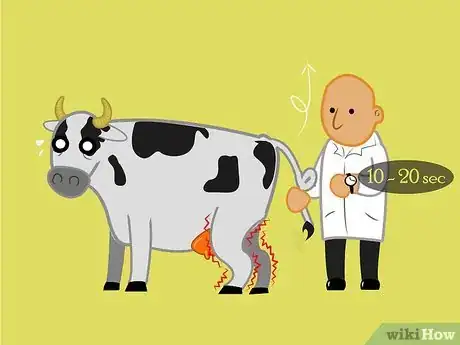

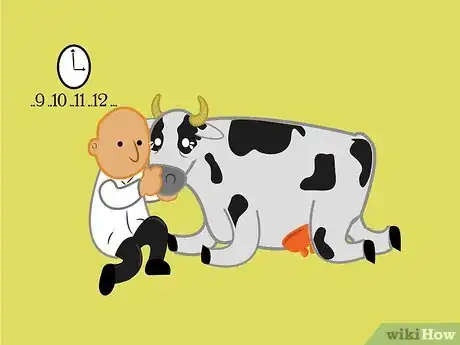
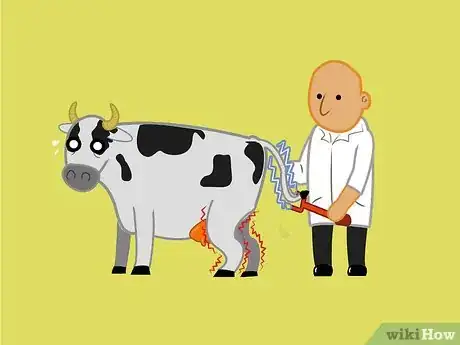
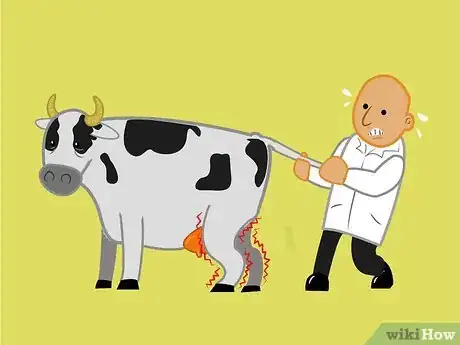
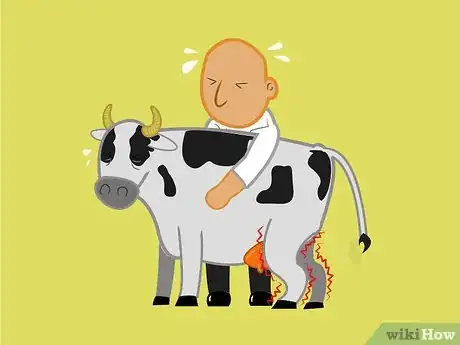
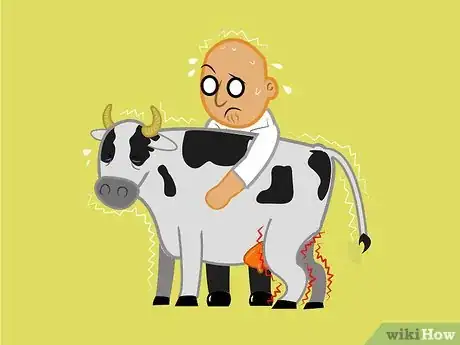
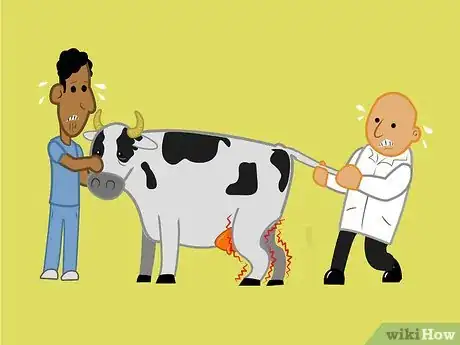

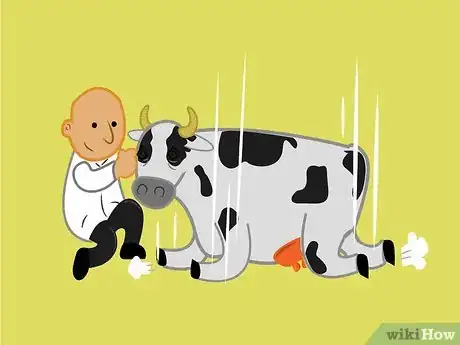
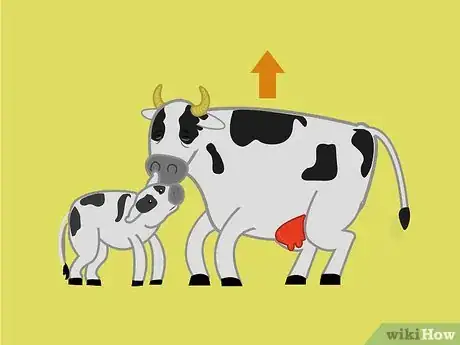
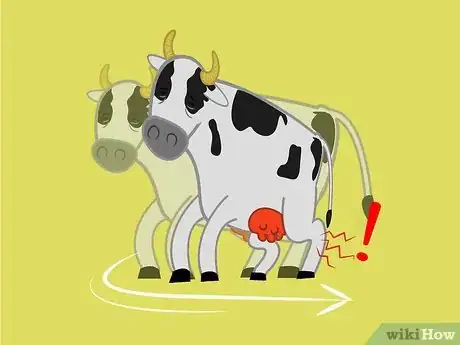
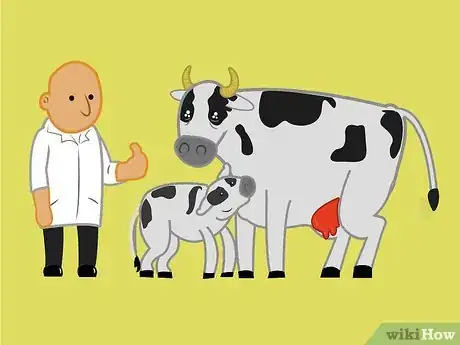
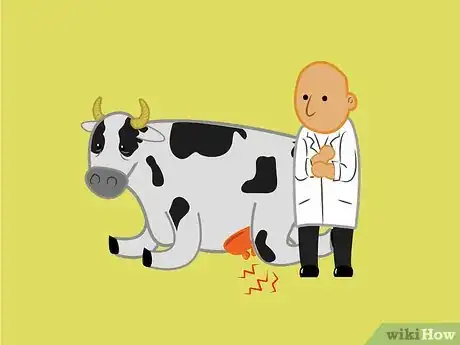
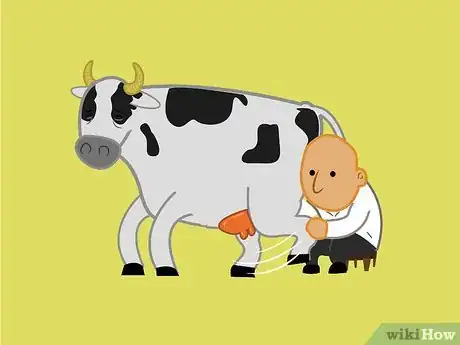

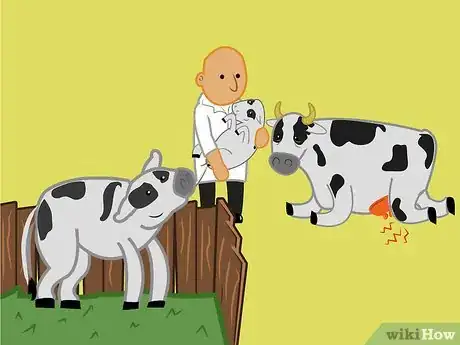
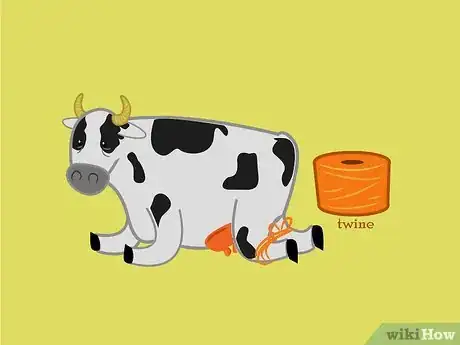

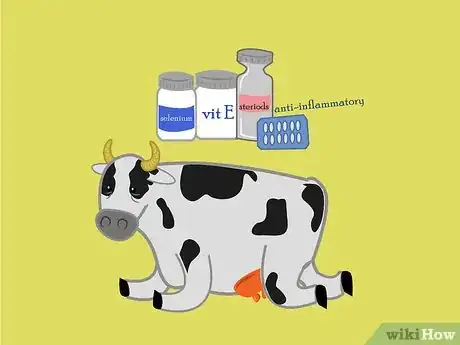
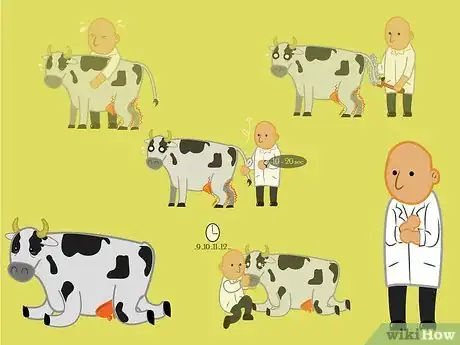


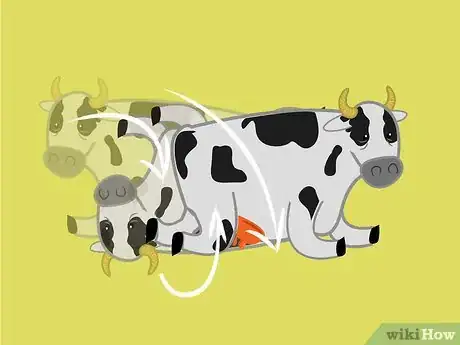
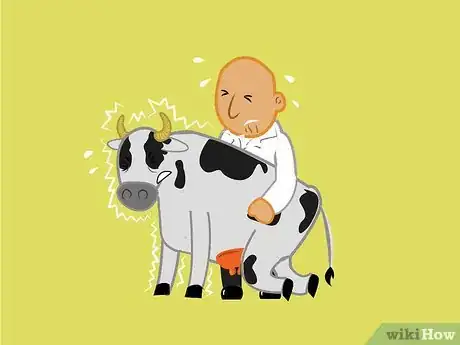



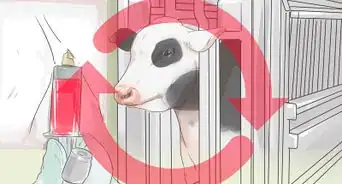
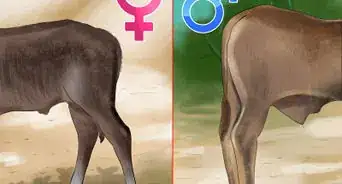
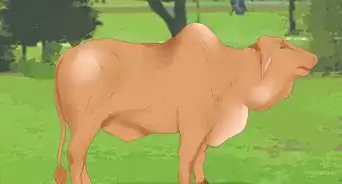
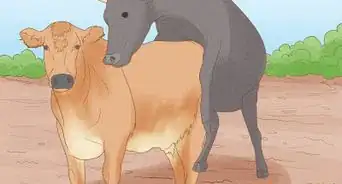
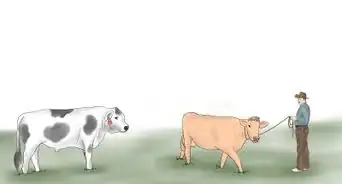

-in-Cattle-Step-6.webp)
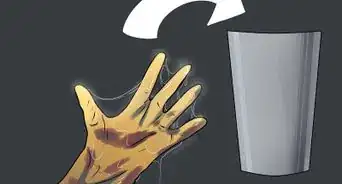











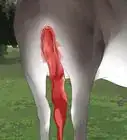
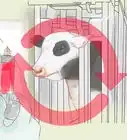
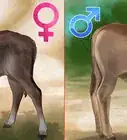



































Medical Disclaimer
The content of this article is not intended to be a substitute for professional medical advice, examination, diagnosis, or treatment. You should always contact your doctor or other qualified healthcare professional before starting, changing, or stopping any kind of health treatment.
Read More...